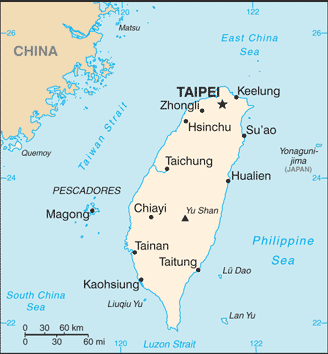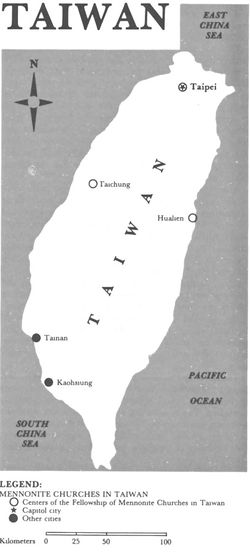Difference between revisions of "Taiwan"
| [checked revision] | [checked revision] |
m (Text replace - "<strong> </strong>" to " ") |
(Revised 1990 article, added map, and added category.) |
||
| Line 1: | Line 1: | ||
| − | [[File: | + | __FORCETOC__ |
| + | __TOC__ | ||
| + | [[File:Tw-map.gif|328px|thumbnail|left|''Taiwan. <br /> | ||
| + | Source: [https://www.cia.gov/library/publications/the-world-factbook/geos/tw.html CIA World Factbook].'']] | ||
| + | [[File:Taiwan1.jpg|323px|thumb|right|''Source: [http://en.wikipedia.org/wiki/File:Locator_map_of_the_ROC_Taiwan.svg Wikipedia Commons]'']] | ||
| + | == Introduction == | ||
| + | Taiwan (officially the Republic of China [ROC]) is an island located 160 km (100 miles) off the southeast coast of China, opposite Fukien Province, astride the Tropic of Cancer halfway between Japan and the Philippines. Two-thirds of the island of 35,883 km2 (13,855 square miles) is mountainous. Formerly known as Formosa (Portuguese for "beautiful island"), Taiwan (Chinese for "terraced bay") is governed by the Nationalist Chinese party (Kuomingtang) as the Republic of China. In 2013 Taiwan had an estimated population of 23,373,517. | ||
| − | + | The island was first occupied by Taiwanese aborigines. In the 17th century both the Dutch and the Spanish established trading outposts on the island. In 1662 the Dutch, who had earlier expelled the Spanish, were expelled by pro-Ming loyalists from mainland China, and the first Han Chinese kingdom was established. The Han Chinese continued to settle on the island and became the majority population. Taiwan came under Japanese control in 1895 but reverted to China in 1945. When the Communist Party of China established the People's Republic of China in 1949, the Republic of China (Nationalist Chinese) government of Chiang Kai-shek relocated to Taiwan. | |
| − | + | In 2009 the Han Chinese constituted 98% of Taiwan's population, including the Hokkien (70%), the Hakka (14%), both early Han Chinese immigrants, and later Han Chinese emigrants from mainland China that settled in Taiwan after 1945 (14%). The other 2% were Aborigines, comprised of 14 Austronesian ethnic groups. Mandarin Chinese is the official language, though the Taiwanese dialect is the mother tongue of the majority. | |
| − | + | Buddhism, Taoism, and religious Confucianism along with popular folk religion are practiced by the people of Taiwan. Only three percent of the population was considered Christian in 1986. The Presbyterian Church of England began mission work in southern Taiwan in 1865 under James Maxwell, and in 1872 George MacKay from the Presbyterian Church of Canada began medical and evangelistic work in northern Taiwan. In 1986 the Presbyterian Church was the largest and oldest Taiwanese Christian church. Following World War II, numerous other mission groups entered Taiwan to establish churches. | |
| − | + | In 2005 81.3% of the population of Taiwan was religious, and 14-18% were non-religious. The largest religious groups were Buddhism (35.1%), Taoism (33%), Yiguandao (3.5%), Protestantism (2.6%), and Roman Catholicism (1.3%). The majority of Taiwanese people usually combine the secular moral teachings of Confucianism with their religion. | |
| + | [[File:ME5_870.jpg|250px|thumb|right|''Mennonite Churches in Taiwan, 1980s.<br /> | ||
| + | Mennonite Encyclopedia, v. 5, p. 870. '']] | ||
| + | == Mennonites in Taiwan == | ||
[[Mennonite Central Committee (International)|Mennonite Central Committee]] (MCC) was invited by the Presbyterian Church to begin relief and medical work in Taiwan in 1948, and the [[General Conference Mennonite Church (GCM)|General Conference Mennonite]] mission followed with church planting work in 1954. In 1986 there were 17 Mennonite congregations of the [[Fellowship of Mennonite Churches in Taiwan|Fellowship of Mennonite Churches in Taiwan]] located in three major cities of Taiwan. In addition the Mennonite Christian Hospital was located on the east coast. | [[Mennonite Central Committee (International)|Mennonite Central Committee]] (MCC) was invited by the Presbyterian Church to begin relief and medical work in Taiwan in 1948, and the [[General Conference Mennonite Church (GCM)|General Conference Mennonite]] mission followed with church planting work in 1954. In 1986 there were 17 Mennonite congregations of the [[Fellowship of Mennonite Churches in Taiwan|Fellowship of Mennonite Churches in Taiwan]] located in three major cities of Taiwan. In addition the Mennonite Christian Hospital was located on the east coast. | ||
| − | + | == 2010 Update== | |
| + | In 2009 the Fellowship of Mennonite Churches in Taiwan had 20 congregations and a total membership of 1,717. Churches were located in three major urban areas: Taipei and Taoyuan, Taichung, and Hualien. | ||
= Bibliography = | = Bibliography = | ||
Kraybill, Paul N., ed. <em class="gameo_bibliography">Mennonite World Handbook.</em> Lombard, IL: Mennonite World Conference, 1978: 183-187. | Kraybill, Paul N., ed. <em class="gameo_bibliography">Mennonite World Handbook.</em> Lombard, IL: Mennonite World Conference, 1978: 183-187. | ||
| Line 20: | Line 30: | ||
Sawatzky, Sheldon V. "The Gateway of Promise: A Study of the Taiwan Mennonite Church and the Factors Affecting Its Growth." MA thesis, Fuller Theological Seminary, 1970. | Sawatzky, Sheldon V. "The Gateway of Promise: A Study of the Taiwan Mennonite Church and the Factors Affecting Its Growth." MA thesis, Fuller Theological Seminary, 1970. | ||
| − | {{GAMEO_footer|hp=Vol. 5, pp. 870-871|date= | + | |
| + | Wikipedia. "Taiwan." 9 May 2014. Web. 19 May 2014. https://en.wikipedia.org/wiki/Taiwan. | ||
| + | {{GAMEO_footer|hp=Vol. 5, pp. 870-871|date=May 2014|a1_last=Sawatzky|a1_first=Sheldon V|a2_last= |a2_first= }} | ||
| + | [[Category:Countries]] | ||
Revision as of 23:28, 19 May 2014

Introduction
Taiwan (officially the Republic of China [ROC]) is an island located 160 km (100 miles) off the southeast coast of China, opposite Fukien Province, astride the Tropic of Cancer halfway between Japan and the Philippines. Two-thirds of the island of 35,883 km2 (13,855 square miles) is mountainous. Formerly known as Formosa (Portuguese for "beautiful island"), Taiwan (Chinese for "terraced bay") is governed by the Nationalist Chinese party (Kuomingtang) as the Republic of China. In 2013 Taiwan had an estimated population of 23,373,517.
The island was first occupied by Taiwanese aborigines. In the 17th century both the Dutch and the Spanish established trading outposts on the island. In 1662 the Dutch, who had earlier expelled the Spanish, were expelled by pro-Ming loyalists from mainland China, and the first Han Chinese kingdom was established. The Han Chinese continued to settle on the island and became the majority population. Taiwan came under Japanese control in 1895 but reverted to China in 1945. When the Communist Party of China established the People's Republic of China in 1949, the Republic of China (Nationalist Chinese) government of Chiang Kai-shek relocated to Taiwan.
In 2009 the Han Chinese constituted 98% of Taiwan's population, including the Hokkien (70%), the Hakka (14%), both early Han Chinese immigrants, and later Han Chinese emigrants from mainland China that settled in Taiwan after 1945 (14%). The other 2% were Aborigines, comprised of 14 Austronesian ethnic groups. Mandarin Chinese is the official language, though the Taiwanese dialect is the mother tongue of the majority.
Buddhism, Taoism, and religious Confucianism along with popular folk religion are practiced by the people of Taiwan. Only three percent of the population was considered Christian in 1986. The Presbyterian Church of England began mission work in southern Taiwan in 1865 under James Maxwell, and in 1872 George MacKay from the Presbyterian Church of Canada began medical and evangelistic work in northern Taiwan. In 1986 the Presbyterian Church was the largest and oldest Taiwanese Christian church. Following World War II, numerous other mission groups entered Taiwan to establish churches.
In 2005 81.3% of the population of Taiwan was religious, and 14-18% were non-religious. The largest religious groups were Buddhism (35.1%), Taoism (33%), Yiguandao (3.5%), Protestantism (2.6%), and Roman Catholicism (1.3%). The majority of Taiwanese people usually combine the secular moral teachings of Confucianism with their religion.
Mennonites in Taiwan
Mennonite Central Committee (MCC) was invited by the Presbyterian Church to begin relief and medical work in Taiwan in 1948, and the General Conference Mennonite mission followed with church planting work in 1954. In 1986 there were 17 Mennonite congregations of the Fellowship of Mennonite Churches in Taiwan located in three major cities of Taiwan. In addition the Mennonite Christian Hospital was located on the east coast.
2010 Update
In 2009 the Fellowship of Mennonite Churches in Taiwan had 20 congregations and a total membership of 1,717. Churches were located in three major urban areas: Taipei and Taoyuan, Taichung, and Hualien.
Bibliography
Kraybill, Paul N., ed. Mennonite World Handbook. Lombard, IL: Mennonite World Conference, 1978: 183-187.
Mennonite World Conference. "Mennonite and Brethren in Christ Churches Worldwide, 2009: Asia & Pacific." 2010. Web. 28 October 2010. http://www.mwc-cmm.org/en15/files/Members 2009/Asia & Pacific Summary.doc.
Mennonite World Handbook Supplement. Strasbourg, France, and Lombard, IL: Mennonite World Conference, 1984: 41
Sawatzky, Sheldon V. "The Gateway of Promise: A Study of the Taiwan Mennonite Church and the Factors Affecting Its Growth." MA thesis, Fuller Theological Seminary, 1970.
Wikipedia. "Taiwan." 9 May 2014. Web. 19 May 2014. https://en.wikipedia.org/wiki/Taiwan.
| Author(s) | Sheldon V Sawatzky |
|---|---|
| Date Published | May 2014 |
Cite This Article
MLA style
Sawatzky, Sheldon V. "Taiwan." Global Anabaptist Mennonite Encyclopedia Online. May 2014. Web. 21 Nov 2024. https://gameo.org/index.php?title=Taiwan&oldid=122217.
APA style
Sawatzky, Sheldon V. (May 2014). Taiwan. Global Anabaptist Mennonite Encyclopedia Online. Retrieved 21 November 2024, from https://gameo.org/index.php?title=Taiwan&oldid=122217.
Adapted by permission of Herald Press, Harrisonburg, Virginia, from Mennonite Encyclopedia, Vol. 5, pp. 870-871. All rights reserved.
©1996-2024 by the Global Anabaptist Mennonite Encyclopedia Online. All rights reserved.


